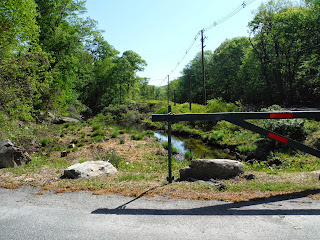Well I came back from my first longer sampling trip of the summer (first of six). The trip takes me from Syracuse to the Delaware River, to the Hudson River, and then back again to Syracuse. Although I went much further this time than when I traveled to the Genesee River the species was the same in both sites (Sea lamprey,
Petromyzon marinus).
The first pictures here will be familiar if you have seen the blog before, as this is the site in the Delaware River where I sampled last year.
The water levels have been very low this year because we have largely not had any rain for weeks. This makes it easier for me to sample, but it is not usual for the time of year. Normally at this time of year the rocks in the lower left of the picture would be completely covered by water.
Here is a view of the same stream just downstream from the bridge. This area should currently be covered in water and should look like this only in June as the trees go to work and the rain falls off.
More of the same really, but I plan to take a picture of the same location latter in the summer and in the fall.
This year I have added another color to my pallet. Last year I used red, yellow, and orange, but this year I will be using blue. You can see the syringes with the color ready to go above this already marked ammocoete.
A few ammocoetes be anesthetized before marking showing a good mixture of the sizes I encounter..
I don't know why I took this picture of the ammocoete upside down, but it is what it is now.
Following my marking of ammocoetes I went further down on the Delaware River to look for spawning adults. The water was still too cold, and adults will probably not move for another 2 weeks, but I wanted to check. Here is a picture of NY-17 passing over the Delaware River.
While I did not find any lamprey I did find a dead American eel (Anguilla rostrata). I do not know how this animal died as it had no obvious marks on its body. American eels were at one point extremely common everywhere in the US west of the Mississippi River, but including the mighty Mississippi. American eels may have made up 1/3rd of all the fish biomass of the US when Europeans first arrived. Sadly eels are relatively rare now, although you can find them their populations are doing quite poorly, and there is even some attempt to list them as an endangered species.
Here is the stream I work on in the Hudson River. I actually do not work here, but the picture is from the head waters of the stream at the park I stayed overnight at when I arrived. Sea lamprey may have used these sections of the stream in the past (although I suspect not), but currently a dam much further down gives them only a small section of stream (just a few miles) to spawn and rear in.
Sorry for the lack of Hudson River pictures. At the time I was working to go through as many animals as possible and I was alone so I was quite busy. Hopefully next time I will have time to take lots of pictures of the site.




























